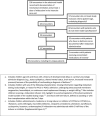Use of Electronic Health Records to Identify Exposure-Response Relationships in Critically Ill Children: An Example of Midazolam and Delirium
- PMID: 36388077
- PMCID: PMC9649289
- DOI: 10.1055/s-0041-1725148
Use of Electronic Health Records to Identify Exposure-Response Relationships in Critically Ill Children: An Example of Midazolam and Delirium
Abstract
Adverse drug events are common in critically ill children and often result from systemic or target organ drug exposure. Methods of drug dosing and titration that consider pharmacokinetic alterations may improve our ability to optimally dose critically ill patients and reduce the risk for drug-related adverse events. To demonstrate this possibility, we explored the exposure-response relationship between midazolam and delirium in critically ill children. We retrospectively examined electronic health records (EHRs) of critically ill children <18 years of age hospitalized in the pediatric intensive care unit at Duke University; these children were administered midazolam during mechanical ventilation and had ≥1 Cornell Assessment of Pediatric Delirium (CAPD) score. We used individual-level data extracted from the EHR and a previously published population pharmacokinetic (PK) model developed in critically ill children to simulate plasma concentrations at the time of CAPD scores in 1,000 representative datasets. We used multilevel repeated measures models, with clustering at patient and simulation levels, to evaluate the associations between measures of drug exposure (e.g., concentration and area under concentration time curve) and delirium scores. We included 61 children, median age 1.5 years (range = 0.1-16.3), with 181 CAPD assessments. We identified similarities between simulated Empirical Bayesian parameter estimates from the EHR cohort and those from the PK model population. We identified a stronger association between drug concentration at the time of score and CAPD scores (coefficient 1.78; 95% confidence interval: 1.66-1.90) compared with cumulative dose per kilogram and CAPD scores (coefficient -0.01; 95% confidence interval: -0.01 to -0.01). EHR and PK models can be leveraged to investigate exposure-response relationships in critically ill children.
Keywords: critically ill children; delirium; midazolam.
Thieme. All rights reserved.
Conflict of interest statement
Conflict of Interest None declared.
References
-
- Eulmesekian P G, Alvarez J P, Ceriani Cernadas J M, Pérez A, Berberis S, Kondratiuk Y. The occurrence of adverse events is associated with increased morbidity and mortality in children admitted to a single pediatric intensive care unit. Eur J Pediatr. 2020;179(03):473–482. - PubMed
-
- Kunac D L, Kennedy J, Austin N, Reith D. Incidence, preventability, and impact of Adverse Drug Events (ADEs) and potential ADEs in hospitalized children in New Zealand: a prospective observational cohort study. Paediatr Drugs. 2009;11(02):153–160. - PubMed
-
- Zuppa A F, Curley M AQ. Sedation analgesia and neuromuscular blockade in pediatric critical care: overview and current landscape. Pediatr Clin North Am. 2017;64(05):1103–1116. - PubMed
-
- Giachetto G A, Telechea H M, Speranza N, Oyarzun M, Nanni L, Menchaca A. Vancomycin pharmacokinetic-pharmacodynamic parameters to optimize dosage administration in critically ill children. Pediatr Crit Care Med. 2011;12(06):e250–e254. - PubMed
LinkOut - more resources
Full Text Sources


